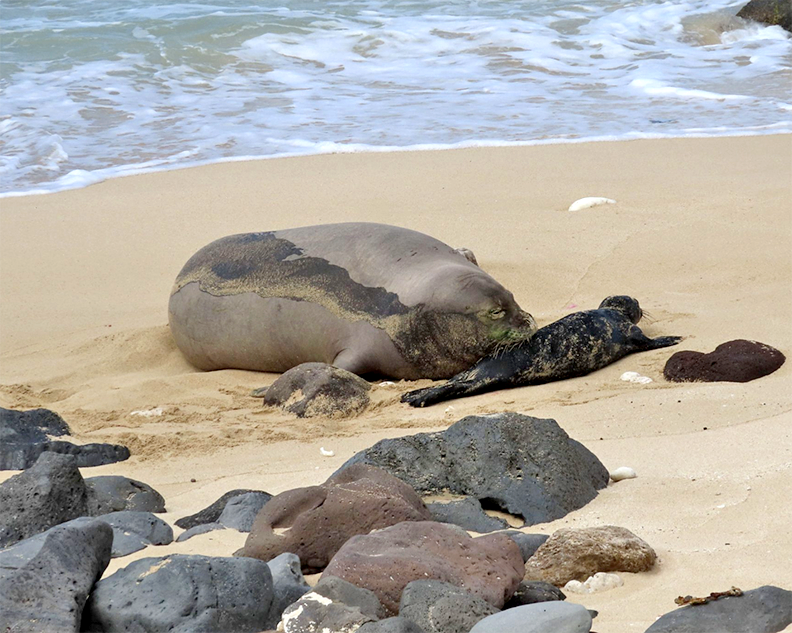By Ruby Pap
Lately, I’ve been having a lot of conversations about water. In California, where I lived before moving here three years ago, water scarcity is common. My friends are often under water restrictions due to drought, and there are all kinds of crazy schemes to import water to hydrate Los Angeles or the Central Valley agricultural areas that grow water-hungry crops.
But here on Kaua‘i, I can’t even count how many times I’ve heard that it is the ‘wettest place on Earth.’
Actually though, it’s not so simple.
The 5,148-foot summit of Mount Waialeale gets a whopping mean annual rainfall of 430 inches. But extending that statement to the whole of the island, assuming there is plenty water for humans and the environment, is almost certainly incorrect.
The water that comes out of our tap comes from wells and tunnels that store groundwater. The availability of the rainwater on top of mountains to the ground, i.e. “groundwater recharge,” depends on numerous factors. Some of the rainwater that falls on the land runs off into the ocean via streams, while the remainder percolates into the soil to recharge the aquifer. How much is recharged depends on the evapotranspiration rate in the soil. If rainfall is less frequent, evapotranspiration has more time to reduce soil moisture and even if you get a large rain event the volumes of recharge to the underlying aquifer is less.

A rainwater catchment system is shown here. Photo by the American Rainwater Catchment Systems Association
Take the Lihu‘e water basin, a 553-square-mile area that is home to half of Kaua‘i’s population and includes Waialeale and numerous streams extending from the Wailua River to Hule‘ia Stream. According to a 2005 United States Geologic Service report, well water levels and productivity have shown a marked decline since the 1980s. This has raised concerns about the future reliability of groundwater sources.
The reason for these declines appear to be three-fold:
(1) Increases in groundwater development; (2) decreases in irrigation – when the sugar plantations closed, this artificial recharge essentially ceased; and (3) decreased rainfall – annual rainfall measured at rain gauges at the Mount Waialeale and Lihu‘e Airport have been below average at times, corresponding with observed declines in the wells.
One alternative to using wells is rainwater catchment, whereby existing roofs and gutters are used to gather rainwater, which is stored in tanks. It is used for potable and non-potable in-home use, livestock, irrigation, wildlife, firefighting or to refill aquifers. Rainwater catchment is popping up all over the Mainland and has been common place for quite some time in other countries, such as Australia.
According to Tim Pope, from the American Rainwater Catchment Systems Association, “the most sincere form of returning water to the aquifer is to not take it out in the first place.”
It also helps solve water quality issues because you are harvesting water out of the sky instead of the ground (assuming the roofing materials are uncontaminated), and if you are in low-lying area it can avoid the saltwater intrusion issue in wells. It even works in areas of lower rainfall like the Westside.
Climate change spells a very uncertain future for freshwater resources in Hawai‘i. We may already be experiencing its effects as evidenced by the historic downward trends in rainfall, streamflow, and longer drought conditions (see http://seagrant.soest.hawaii.edu/sites/default/files/publications/smfinal-hawaiiclimatechange.pdf).
Predicting the future is complicated due to the complex and variable nature of rainfall over each island. A lot of modeling research is being undertaken in academia but it lacks concrete conclusions about future conditions.
This uncertainty is enough to cause concern and an abundance of caution when using groundwater resources. The more I learn about rainwater catchment, the more it feels like a no-brainer.
Visit www.arcsa.org for more information.
- Ruby Pap is a Coastal Land Use Extension Agent at University of Hawai‘i Sea Grant College Program. She can be reached at rpap@hawaii.edu.
Photo Caption
A rainwater catchment system is shown here. Photo by the American Rainwater Catchment Systems Association.
Discover more from ForKauaiOnline
Subscribe to get the latest posts sent to your email.






Leave a Reply